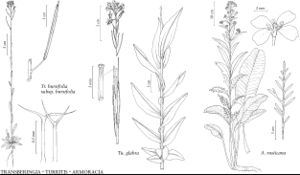Transberingia
| Taxon | Illustrator ⠉ | |
|---|---|---|
 | Transberingia bursifolia Transberingia bursifolia subsp. bursifolia Turritis glabra Armoracia rusticana | Yevonn Wilson-Ramsey Yevonn Wilson-Ramsey Yevonn Wilson-Ramsey Barbara Alongi |
Perennials; not scapose; glabrous or pubescent, trichomes simple, forked, stalked, or dendritic. Stems erect or ascending, unbranched or branched basally and distally. Leaves basal and cauline; petiolate or sessile; basal rosulate, petiolate, blade margins often entire, sometimes dentate, rarely sinuate; cauline blade (base not auriculate, sagittate), margins usually entire, rarely dentate. Racemes (corymbose, several-flowered), elongated in fruit. Fruiting pedicels ascending to subdivaricate, slender (terete). Flowers: sepals erect, oblong, (pubescent); petals white, oblanceolate, (longer than sepals), claw obscurely differentiated from blade, (apex obtuse); stamens slightly tetradynamous; filaments not dilated basally; anthers oblong, (apiculate); nectar glands confluent, subtending bases of stamens. Fruits siliques, dehiscent, sessile or subsessile, linear, smooth, terete; valves each with prominent midvein and marginal veins, secondary-veins anastomosing and distinct or obscure, glabrous; replum rounded; septum complete; ovules 70–150 per ovary; (style obsolete or distinct); stigma capitate. Seeds biseriate, plump, not winged, narrowly oblong; seed-coat (minutely reticulate), not mucilaginous when wetted; cotyledons incumbent. x = 8.
Distribution
n, w North America, e Asia (Russian Far East)
Discussion
Species 1.
For discussion of the generic limits of Transberingia, see the original description and also under 60. Halimolobos.
Selected References
None.
Lower Taxa
"elongated" is not a number."thick" is not a number.